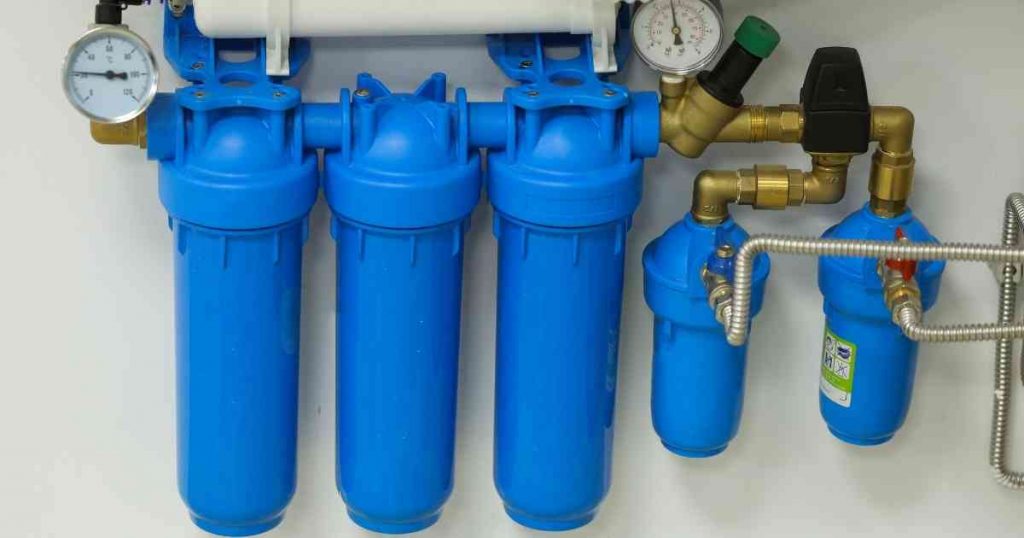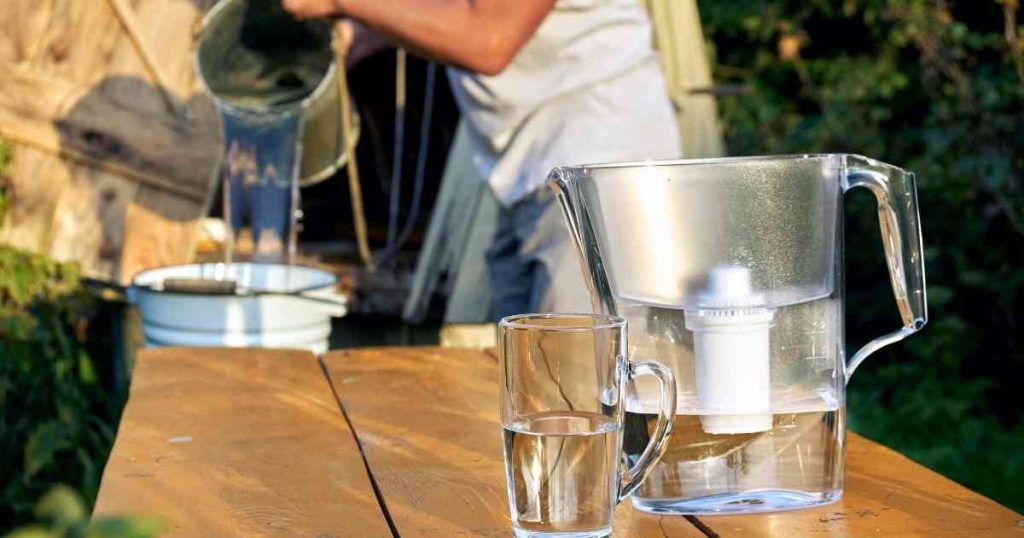Iron is an essential element, one of those nutrients we need to grow, develop and transport oxygen for proper bodily function.
Sadly, iron in its precipitate form changes the color of water and can cause cosmetic damage around your house. It can stain your clothes, earthenware, and cutlery. It can also give the water an unpleasant taste and smell.
If you are sick of cleaning brown iron, stains from multiple locations around your home and need to find an affordable way of removing iron from well water, this blog post has the answers you need.
Below are the five cheapest way to remove iron from well water while saving a sizeable amount of money.
But first, you should take specific steps to determine the concentration and type of iron present in the well water for the best results. Let’s go over that first.
Types of Iron Found in Well Water

Iron is a typical component of a healthy diet in minuscule amounts. However, when the concentration of iron in the water rises to about 0.3 PPM and above, the water’s color, taste, and odor will start to change. These adverse effects are also determined by the type of iron found in the well water. The three major types iron contamination include:
Ferrous Iron
Ferrous iron completely dissolves in water and cannot be detected by running your faucet. Initially, you might not suspect iron contamination if the water runs clear and you may think something else is causing brown residue. But even if the water is clear, this soluble form of iron will oxidize over time, and you will be left with the brownish-orange stain. Treatment methods will require oxidation first before the iron is filtered out.
Ferric Iron
Ferric iron is the opposite of ferrous iron. Ferric iron is already partially oxidized, so it exists as particulate matter in water, giving it the unsightly brown rusty color. This is most prevalent in well water and is a common form of iron contamination you are likely to encounter in your home.
Bacterial Iron/Organic Iron
Bacterial iron is formed from bacteria and iron sitting together in water over a long period of time. The bacteria mix with the iron and other chemicals to generate slimy rusty particulate matter suspended in the water. Treatment methods for bacterial iron require a chemical injection, a process that can be quite expensive.
How To Test for Iron in Well Water

If you have been noticing brownish-orange stains around your toilets and sink or have been dealing with iron stains on cups and cutlery, there is a good chance that you have iron in your well water. However, before making any decision, you must test for iron content in the water properly.
Visually Test for Iron Content in Well Water
To confirm if the brownish-orange stains are coming from the water supply, check if the water is orange or brownish-colored. In higher concentrations of ferric iron, completely brown-colored water will run from the faucets and the well.
If you are unsure and the color is neutral, place some water into a cup and let it sit for an hour or two; if ferrous iron is present, oxidation will occur upon exposure to air, and the water will change color.
The presence of bacterial iron is denoted by slimy orange-brown matter that floats on top of the water or is dispersed in the water.
Chemically Test for Iron Content in Well Water
Chemical tests are important because not all brown stains or orange-colored water are caused by iron. They can also be caused by tannins – naturally occurring materials formed from the breakdown of vegetation. Chemical tests give an accurate representation of the iron levels in water. They also help to identify the type of iron contamination in water.
In most cases, you would need to send a sample of the water to a lab for detailed composition results of any other contaminants in the water.
Simple chemical tests at home include:
- Using an Iron removal chemical
- Using home kits to test for iron
- Using a universal/iron test strip
5 Cheapest Ways to Remove Iron from Well Water
1. Sedimentation Filtration

Using a sediment filter to remove iron from well water is one of the cheapest options to consider if you are dealing with ferric iron. The filter is designed to keep the particulate iron and other fine matter out of the water that runs in your house and is very easy to set up. The most crucial factor to take into consideration is the filter size. One micron or finer offers the best results to get rid of ferric iron.
2. Filtration With Oxidizing Agent
In terms of cost considerations, you can improve a sedimentation filter’s effectiveness by combining it with the use of an oxidizing agent to filter out both ferric and ferrous iron.
To remove iron, add an oxidizing agent like potassium permanganate to the water and allow sitting time for the water to be oxidized. All the iron dissolved in the water will precipitate out after a few hours and form particulate sediment at the bottom of the tank. Next, the water is passed through an activated carbon filter to remove the iron particulates as well as dirt, residue, and the oxidizing agent itself from the water, making it safe to use.
3. Chlorination

Chlorination is one of the cheapest ways to remove iron from well water. It converts soluble iron (dissolved in water) into oxidized iron, ready to be filtered out of your well water. You can use household bleach, a diluted sodium hypochlorite solution, and white vinegar used for baking to disinfect your well water and remove iron from it. Then flush the well and plumbing system after a contact period to remove all the chlorine from the system. Alternatively, you can call a professional to install a continuous chlorinated system that will effectively remove bacterial iron. The chlorination method can be combined with a filter to remove oxidized iron simultaneously.
4. Water Softener

A water softener uses negatively charged resin beads to soften water by removing positively charged iron from the water. This process also attracts the positively charged ferrous iron ions to the resin beads, thereby removing the ferrous iron from the water. This makes an ion exchange water softener one of the cheapest ways to remove iron from well water. Although it is not 100% effective for ferric iron (and the system needs to be flushed periodically to remove accumulated iron) you can improve the efficiency by adding a sedimentation filtration system for your well water.
5. Iron Removal Filter Cartridge
Iron removal filter cartridges are another affordable option for removing iron from well water. It can filter out ferric and ferrous iron from well water. The iron filter uses a cartridge that removes iron and manganese from the water. It is an easy system to install and manage and it will optimally remove iron from well water. For iron removal water filters, the pH of the water is critical as it determines its potency. Consider the filter’s recommended operation conditions to ensure your filter will work properly.
Other Iron Removal Methods to consider
- Reverse osmosis filtration: This method is costly, but you can achieve 100% purity.
- Chemical oxidation/injection: Uses a continuous chemical system to filter water constantly.
- Ozone Generator: Uses ozone to oxidize iron out of the water, ideal as a permanent solution.
How Does Iron Get into Well Water?
You may be wondering how iron gets into well water in the first place and what you can do to prevent it. Iron is one of the most abundant elements on earth, and as a result, can be found everywhere. It occurs naturally within the earth’s crust and makes its way into wells as the water is pumped from beneath the earth’s surface.
Corrosion is the other primary reason why iron is found in well water. Corrosion from rusted pipes, fittings, and nails of any steel or iron variants can contaminate the water.
Lastly, any iron or steel fixtures in the well structure itself can corrode over time due to exposure to the wet environment and will add to the iron composition of the well water.
Related Questions
Do Water Softeners Remove Iron?
Although not 100% effective, water softeners remove a significant amount of ferrous iron from well water and are a great choice if your well water does not contain ferric iron. It works best when combined with a sedimentation filter and an oxidizing agent to extract the dissolved iron before passing through the water softener. Used separately, it cannot remove large amounts of iron from water, especially in a large home.
How Do You Remove Iron from Water Yourself?
The least expensive and easiest way to remove iron from water is to filter the water after sedimentation. Pour contaminated water into the desired container and let it sit overnight for sedimentation to occur. Once all the iron forms sediment below, filter the water manually or use a filtration cloth. To achieve the same effect throughout your home’s plumbing, you must install a sediment filter that will remove iron from your well water without backwash.
Best Way to Remove Iron from Well Water?
Reverse osmosis filtration is the most effective way to remove iron from well water. This method uses up to a thousand layers of membrane to remove contaminants based on their size and charge. It can remove all types of iron, salts, manganese, hydrogen sulfide, bacteria, microorganisms, and more, making the water extremely pure and safe for drinking.
How To Remove Iron from Water at Home?
To remove iron from water at home, you may install a separate filter housing to your plumbing/water system. This will sometimes include installing an additional retention tank or pressure tank for best results. Apart from sedimentation filtration, other methods to consider include:
- Filtration with an oxidizing agent
- Chlorination
- Water softener
- Iron removal filter
- Aeration
- Ozone generator
- Chemical oxidation
- Reverse Osmosis filtration
Is Well Water High in Iron Safe to Drink?
While iron in small quantities does not have any harmful health effects, iron consumed in higher amounts in water (0.3 PPM and higher) can cause topical and internal health problems. The presence of iron in drinking water can harm skin cells, cause dehydration, diarrhea, abdominal pain, low blood pressure, seizures, and even multi-organ failure.
Conclusion
Now you know the cheapest way to remove iron from well water – so what’s next?
It’s time to choose from the top five cheapest methods in this blog post.
Sediment filters work best for ferric iron. You can use filtration with an oxidizing agent to capture and remove ferric and ferrous iron.
If you want a chemical option, chlorination with household bleach works best, and iron chemical filter removal is a great option too.
These options are affordable, even for large homes, and will fit nicely within your budget. So go ahead and make your best choice. See more articles here for more advice on safe drinking water.

